Museums and Exhibitions in New York City and Vicinity
| Home | | Museum Guide | | International | | Architecture & Design | | Theater |
GLENN LONEY'S MUSEUM NOTES
CONTENTS, February 2005
Please click on "
* " to skip to each subject in this index:
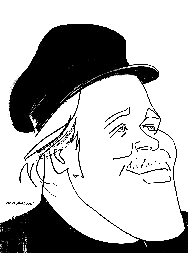
|
|
| Caricature of Glenn Loney by Sam Norkin. | |
TIM HAWKINSON *
CY TWOMBLY: Fifty Years of Works on Paper *
ELLEN GALLAGHER: DeLuxe *
PETER PAUL RUBENS (1577-1640): The Drawings *
FROM FILIPPO LIPPI TO PIERO DELLA FRANCESCA *
CONTEMPORARY VOICES: works from The UBS Art Collection *
I WANNA BE LOVED BY YOU: Photographs of Marilyn Monroe from the Leon &
Michaela Constantiner Collection *
Visible Storage—Study Center *
DISCO: A Decade of Saturday Nights *
FIRST SEEN: Photographs of the World’s Peoples, 1840-1880 *
ARRIVING IN STYLE *
OUTSIDER ART FAIR 2005 *
At the Whitney Museum of American Art—
TIM
HAWKINSON
[Closing May 29, 2005]
Slim, semi-serious, be-spectacled, youthful Tim Hawkinson doesn’t look anything like one of those Mad Scientists of B-Movie Lore. And yet, his major works now on display at the Whitney and the IBM Atrium could well have been imagined and constructed by a demented Sci-Fi genius.
In fact, some of his remarkable & unusual machines could have been inspired by the long-gone cartoons of Rube Goldberg. These incredibly complicated comic contraptions were devised to accomplish the most ordinary of actions. Hawkinson’s creations, on the other hand, seem in service of both the Mundane and the Surreal.
When you exit the fourth-floor elevator at the Whitney—at Madison & 75th—you are immediately confronted by a room-filling robotic sculpture in which brown figures are variously involved with a giant tangle of sonotubes. This is called Pentecost, and it’s compounded from the tubes, polyurethane, solenoids, computer-programs, and various mechanical elements.
If you are fascinated enough by the variety of inventions at the Whitney, you will be amazed at the atrium-filling Überorgan in the IBM Building on Madison at 57th. This also has sonotubes, but it looks like an immense translucent white bagpipe, endlessly replicating itself and its chanters. It expands into the four-stories of the atrium like a Great White Whale of player-piano-sound. In fact, it plays Hawkinson’s music on the hour from an immense player-roll which extends from the floor to the ceiling.
Hawkinson’s use of electronic programs, circuits, and contacts to operate his large-scale creations demonstrate and ingenuity and technical know-how which could make him a millionaire in service of Verizon or Apple. But he will surely make his millions from his fantastic works of art & engineering.
These are not merely fascinating machines but also sculptural objects of unique appeal. Near a Marcel Breuer window at the Whitney, an old school-desk is swamped in a small mountain of paper-snippets. During the length of the show, this mound will grow, because an automatic hand is writing Hawkinson’s signature endlessly from a revolving circular template. It’s rather like a Donald Rumsfeld robot signing all those letters to families of American servicemen killed in Iraq! This contraption is appropriately titled Signature.
Another machine with electronic contacts and ingenious programming changes the facial expressions on a portrait hanging on the nearby wall. This is called Emoter, and it’s rather unsettling to watch after a few minutes.
Many of Hawkinson’s creations are inspired by his own body and functions. Nor are they all large-scale nor mechanized. There’s a very small feather, made of his own hair. And a tiny bird, made of finger-nail parings!
CY TWOMBLY: Fifty Years of Works on Paper
[Closing May 8, 2005]
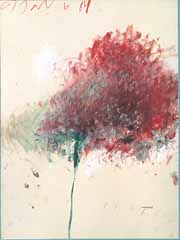 |
| Cy Twombly's Proteus, on view at the Whitney. |
If the colorful but deliberately slapdash watercolor works on view at the Whitney really do represent 50 years of artistic toil by Cy Twombly, they don’t seem to suggest much artistic growth or imagination over those long, long decades. Of course, in the World of Modern Art—now known as Contemporary Art, when invoked in reference to talents still at work churning out would-be masterpieces—the most important item on the artistic agenda is to establish a Signature Style so one’s work is instantly recognizable to Collectors, Curators, and students of Art-History.
Slapslashing the word VENUS on a sheet replete with color-doodles and other mythic words is enough to provoke essays on the Classical Influences on the painter. Indeed, the encomia of various Certified Intellectuals are highlighted in this exhibition, just in case the casual spectator might wonder at what’s on the Whitney’s walls.
Strangely enough, Venus is almost seen to better advantage in the Fifth Avenue show-window of Bergdorf-Goodman, where it forms a backdrop for some spritely spring outfits. Other similar Twombly works—also on view at the Whitney—are downstaged by other frocks in other B-G windows. The window-dressers’ problem has been to find dresses whose colors complement the color-splashes in the large-scale Twombly reproductions. This looks like Product-Placement in reverse…
A number of the works in the Twombly show are titled Untitled. This is hardly a Twombly innovation. Modern Artists have been doing this for quite some time. [Just imagine going to Florence to see Michelangelo’s Untitled in the Accademia! Or to the Louvre to see the Untitled of Samothrace?]
How are curators, archivists, and cataloguers dealing with this? If you do a Google-Search for artworks with the all-too-ubiquitous title of Untitled, how many hundreds of items will be printed out? If the artist has taken the time to scribble something or splatter some color on a piece of paper, why not give it a name? Green Splash #5, perhaps?
[Closing May 1, 2005]
The densely massed small-scale prints of Ellen Gallagher are something else altogether! The battery of sixty prints closely set on a white Whitney wall make an immediate impression: Complex imagery, with a lot of Yellow…
Each of these prints, however, deserves close study. Gallagher has used images from advertising and art to collage and critique conventional attitudes about being black, being oneself, being admired, and even being alive. There is a lot of tart humor and incisive social critique in these prints. And they are often handsome to behold in terms of style, line, color, and composition.
At the Metropolitan Museum of Art—
PETER PAUL RUBENS (1577-1640): The Drawings
[Closing April 3, 2005]
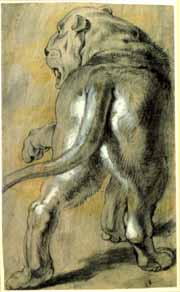 |
| Peter Paul Rubens
(Flemish, 1577-1640) Lioness Seen from the Rear, Turning to the Left,
ca. 1613. Black chalk, with touches of yellow chalk, heightened with white
oil or bodycolor, some gray wash, laid down, 396 x 235 mm (15-9/16 x 9-1/4
in.) The British Museum, London 1994.5.14.46. |
It’s well known that some of Rubens’ most famous major canvases were not completely the brushwork of this immensely gifted Renaissance Man. With the number and scale of the commissions Rubens received, it would have been impossible for him to have executed all these masterworks, had it not been for student-artists and colleagues in his studio, who painted the details of big paintings he’d sketeched out.
Now, for the first time in the United States, an amazing variety of Rubens’ personal sketches are on view at the Met. These were not made for public sale, but, rather, retained by the Master as studies for specific much larger works, or for his own and his students’ reference. Indeed, at his death, he was intent that they should remain in the family, or failing another artist-Rubens, with an artist who would understand how to use them.
Thus, these sketches have a directness, frankness, and freshness that speaks to us over the centuries. A drawing of the head one of his major patrons, Maria de Medici—to whom he was also an advisor and friend—shows her with a rather unflattering double-chin. This detail does not emerge in the large canvases featuring the powerful French Queen.
On view are not only details for major religious paintings but also charming sketches of farm animals and energy-pent lions. It would seem that the Master was interested in All Things Great and Small: details of a hand, wrinkles in an aged face, dancing peasants…
This handsomely mounted show also includes large-scale photos of the Renaissance Palace Rubens retired to when he returned to his Flemish homeland after years abroad in service not only as painter, but also as diplomat for—and advisor to—several courts. Rubens’ career was many-faceted: his genius was revealed not only in his art, but also in his life.
FROM FILIPPO LIPPI TO PIERO DELLA FRANCESCA
[Closing May 1, 2005]
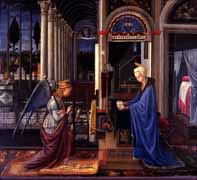 |
| Fra Carnevale (?) (ca. 1420/25-1484) The Annunciation. Tempera and gold on wood, 69.9 x 78 cm. Alte Pinakothek,Munich (inv. no. 645) |
It is a great gift to New York to have such a range of remarkable Italian Renaissance masterworks on view in the Lehman Wing of the Metropolitan. Although his name does not appear in the show’s title, its focus is on a previously almost unknown master and contemporary of Lippi and della Francesca: Fra Carnevale.
His name was mentioned with favor by Giorgio Vasari, in his Lives of the Artists, but his works were virtually unknown. Two of them, known as the Barberini Panels, were sold separately in the 1930s to the Metropolitan and to the Boston Museum of Art. At that time, however, there was no solid artist-attribution.
Thus, an important aspect of this exhibition is the scholarly art-history detective-work which definitively established his credits and career. As a talented layman—born Bartolomeo di Giovanni Corradini in Urbino—he went to Florence to study in Fra Lippi’s workshop. Here he also came into contact with some of the greatest artists of the Renaissance.
Returning to Urbino, he entered the service of Duke Federigo da Montefeltro as painter and architectural advisor. Perhaps inspired by the example of Florentine Masters who were also in religious orders, he became a Dominican, with the name of Fra Carnevale. Eventually, he even became a parish priest in Urbino, devoting himself more to his flock and the fabric of his church than to his painting. Even the church has not survived.
There are illustrated large-scale text-panels which explicate the innovations and practices of Fra Carnevale in his painting. The two Barberini Panels are shown twice: in opposing relation to each other. Their visual impact in each of these two conformations is stunning—but quite different.
But far more important are the masterpieces which could have inspired him: Lippi’s Madonna and Child, The Annunciation, and Saint Lawrence Enthroned, as well as works by Boccati, Pesellino, della Robbia, Duccio, and della Francesca.
At the Museum of Modern Art—
CONTEMPORARY VOICES: works from The UBS Art Collection
[Closing April 25, 2005]
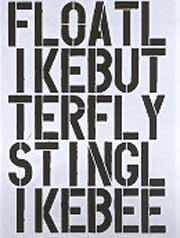 |
| Christopher Wool. Untitled, 1998. UBS Art Collection. |
Talk about Product Placement! It is pervasive enough in current films: even Lord Webber’s Phantom of the Opera had a major Swarovski Crystal placement hard by the Paris Opera!
Now the Museum of Modern Art has put its patronage on very public view. Contemporary Voices speaks very loudly to the presence in our city and nation of UBS—which began life in Basel as the United Bank of Switzerland. Part of its global expansion strategy has been to ingest New York’s PaineWebber. Not to be confused with Credit Suisse, which acquired First Boston…
Part of the PaineWebber acquisition also involved the considerable holdings of the PaineWebber Art Collection. Back in the 1960s—when the Kennedy Royal Family had helped make culture important in our National Life—building art-collections became a useful public-relations gambit by some banks and major corporations.
Along with the founding of the NEA and the NEH, this was widely seen as a good way to fund struggling contemporary artists—with the added advantage of not having to dip into the US Treasury as did the Endowments. Chase-Manhattan was also early on the art-bandwagon.
In the event, it was usually not the marginal, really struggling, artists who were aided by Corporate Collecting. The Acquisitions Advisors were not so foolish as to waste funds on works by Total Unknowns. Critically admired Approved Contemporary Brand-Names were the targets of this largesse.
The Rich got Richer, as did Arrived & Certified Contemporary Artists, because their works could only increase in value. Not to overlook the prestige and publicity generated by advertising the banks’ and corporations’ arts-patronage.
This did not mean that you would see Chase-Manhattan’s Donald Judd or Robert Motherwell on the wall of your local branch-bank. As for CitiBank, its treasures were more often on view in the upper floors of its Post-Modernist Palace on Park Avenue.
In fairness to PaineWebber, however, its artworks—as well as impressive special exhibitions—were often on display in the ground-floor galleries of its midtown Manhattan headquarters. It was always sharing its extensive holdings.
Now it has given MoMA some of its most valuable paintings outright, with the promise of more to come. This has generated an avalanche of publicity for UBS & PaineWebber, but it has been handsomely paid-for—extending even to a handsome catalogue of the exhibition.
The donated and loaned artworks are now shown in the new fourth-floor galleries of the New MoMA. This dazzling white venue—with its flexible walls—shows them off to maximum effect. Many of the Big Names of Contemporary Art are on parade. The Whitney could never have received this gift for it includes European Artists!
Whoever made the initial purchases for PaineWebber knew very well what he or she was doing, as only those artists who were wise enough to develop Signature Subjects & Styles are on view. You don’t have to be an art-historian or student to recognize the work of Anselm Kiefer, Thomas Struth, Andreas Gursky, Damien Hirst, Gerhard Richter, Claes Oldenburg, Chuck Close, Philip Guston, Lucien Freud, Brice Marden, Willem de Kooning, Ed Ruscha, Francesco Clemente, Cindy Sherman, Jenny Holzer, Cy Twombly, David Salle, Claes Oldenburg, Donald Judd, and, of course, Andy Warhol!
When you see some fluorescent lighting-tubes of varied lengths or colors packed together, you just have to know that they are sculptures by Dan Flavin. These are his Signature, his Artist-Imprint on Eternity! Fortunately, PaineWebber was able to acquire at least one of these. But they do need to be plugged into a wall-socket, or they are totally Effectless. This is yet another example of Contemporary Art that cannot stand by and for itself.
At least Tim Hawkinson’s fabulous constructions at the Whitney are still fantastic experiences, even when they are not plugged-in. Think what Rodin might have achieved had he been able to plug his bronzes into a wall-socket: the Burghers of Calais actually moving in place!
At the Brooklyn Museum—
I WANNA BE LOVED BY YOU: Photographs of Marilyn Monroe from the Leon & Michaela Constantiner Collection
[Closing March 20, 2005]
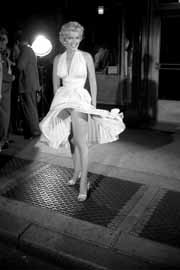 |
| Marilyn
Monroe, "The Seven Year Itch." New York City, 1954. Gelatin
silver print 19 3/4 x 16 in. (50.2 x 40.6 cm) © George S. Zimbel 1954/2004. All Rights Reserved.From the Brooklyn Museum exhibition: "I Wanna Be Loved By You: Photographs of Marilyn Monroe from the Leon and Michaela Constantiner Collection." |
Some of the Marilyn Images in this show are now Iconic: they have been reproduced so much that they need no captions for people all over the world to recognise who this beautiful blonde woman is. For lovers [platonic] of Marilyn Monroe—and film-buffs in general—these alone are worth a trip to the Brooklyn Museum out on Eastern Parkway.
But there are also the private shots of professional photographers who knew Marilyn and were trusted by her. These are even more revealing of the stressed, frustrated, insecure girl-woman behind the posed professional façade. Among these are Bert Stern’s Last Sitting series.
There are some 200 photos on view, taken by 39 photographers, including Richard Avedon, Cecil Beaton, Cornell Capa, Henri Cartier-Bresson, Milton Greene, Phillipe Halsman, Weegee, Gary Winograd, and Stern. They span her life from 1945—when she was Norma Jean Baker—to the weeks before her death in 1962, aged only 36.
There are also film-footages, posters, and other Marilyn Memorabilia to round out this nostalgic display of America’s All-Time Sex-Goddess. Leon Constantiner is clearly a collector in love—if not downright obsessed—with his subject.
[Seeing this show reminded me that I could also once have had a nice collection of Marilyn Memorabilia. When I was doing research for my book on Jack Cole—who was the only person Marilyn would trust to be with her on set and help her when she was filming—I tracked down one of Cole’s suitcases which contained, among other valuable items, her white gloves and fan from Some Like It Hot, as well as photos in costume and in action. I urged Paul Stiga—the owner of the suitcase and its contents—to donate it to the Theatre Collection of the UCLA Library. The materials should still be on file, along with other Cole Memorabilia I had found in writing Unsung Genius: The Passion of Jack Cole.]
LUCE CENTER FOR AMERICAN ART:
[Permanent Installation]
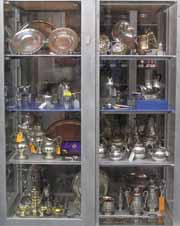 |
| A grouping of silver objects. Luce Center for American Art. Visible Storage Study Center. Brooklyn Museum Collection. Photo credit: Photo by Adam Husted. |
Whatever reservations you may have about The Readers Digest and Time/Life magazines, you must admire their publishers—DeWitt & Lila Acheson Wallace and Henry Luce—for the extensive and bountiful foundation grants that have been made all over America to major and minor museums. The monumental flower-arrangements in the lobby of the Metropolitan Museum—changed each week—are Mrs. Wallace’s gift.
But over in the American Wing, the Henry Luce Study Center makes it possible for curators, researchers, students, and the general public to see up close—and very compactly arranged—many treasures from the permanent collections that would otherwise be virtually inaccessible in the Met’s vaults.
Recently, the New-York Historical Society opened its own version of the Luce Study Center. As at the Met, this makes many fascinating items relating to the history of New York City and State easily available for study and enjoyment.
The Brooklyn Museum—with major holdings in American Arts & Crafts—now has its own Luce Study Center. This is not as large nor as comprehensive as the Met’s, but that is a problem of the Space Available, rather than an insufficiency of important Americana.
Historic objects, photos, documents, artworks, and even furniture are displayed in tiered glass cases. Everything is very closely packed, so period clambers onto period. There isn’t room for extensive wall-texts or labels. Instead, each item has a code number. Visitors, students, and researchers type these codes into handy computer terminals and full information and backgrounds flash onto the monitor.
Some items, such as collections of sketches or photographs, will be shown in rotation. Sliding racks behind the main chamber of glass-cases hold scores of paintings. These can be rolled out for closer examination of works that may not be important enough to be on permanent display.
Among the varied period-pieces of furniture, my favorite is a 19th century player-piano which can be converted into a bed! Dreams with music, anyone?
At the NYPL Lincoln Center Library of the Performing Arts—
DISCO: A Decade of Saturday Nights
[Closing May 14, 2005]
I never stood in line to get into Studio 54, but I certainly did know some of the celebrities who were regulars and never had to stand in line anywhere. Max’s Kansas City was about my speed in the 1960s. As a drama-critic and university professor with evening seminars, I never had time for Disco. But, as a Contributing Editor for the late, lamented After Dark, I received regular breathless reports from staffers who made the rounds every night.
Not just on Saturday Night. Unfortunately, some of these disco-journalists burned out or fried-up. So the current Disco display at the Lincoln Center Library of the Performing Arts is not as compelling for me as it may be to Manhattan Boomers.
Like Starbucks™, this show originated in Seattle, which seems an odd natal-venue, considering that Disco’s roots were firmly planted in Manhattan. The light-level of the exhibition is very low, so you will occasionally have to squint closely at photos, sheet-music, posters, and wall-texts to learn more about this costume, that set of drums, or this record-jacket.
The dimness, of course, also serves as atmosphere-inducing. That Saturday Night Fever white-suit, however, seems to have been worn not by John Travolta, but his body-double. Oh shucks! If you missed Bianca Jagger’s infamous entrance into Studio 54 on horseback, there’s a photo-blowup
You can hear the famous recordings. You can see film & TV footage on a dozen monitors. Celebrity interviews are on tap. You can even mix your own disco-sound in an inter-active DJ booth.
There are some 200 Disco Artifacts, including Earl Young’s drums that first thumped out the Disco-Beat. There’s also a fashion by Halston, who was a Studio 54 regular.
As the holdings of the Lincoln Center Library cover American Theatre all the way back to the Colonial Period, some theatre buffs may wish that an earlier period than the 1960s had been explored. Not that Victor Herbert or Reginald DeKoven would pull in the crowds more than the BeeGees.
In fact, the current show seems a deliberate attempt to lure a younger group of New Yorkers into the Performing Arts Library. Good Luck!
The ill-starred creators of Broadway’s Good Vibrations must have had the same idea about the music of the Beach Boys. Mama Mia! it is not.
At The Dahesh Museum of Art—
FIRST SEEN: Photographs of the World’s Peoples, 1840-1880
[Closing May 1, 2005]
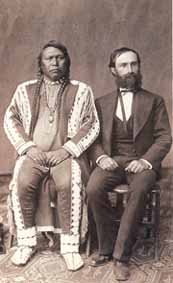 |
| Post-Civil War Photo of Ute Chief and US Photographer William Henry Jackson, on view at Dahesh in First Seen. |
Celebrating 19th century French & English Academic Art is the worthy mission of the Dahesh Museum. The impressive technical skills and the attention to realistic [and romantic] details demonstrated by artists shown at the Dahesh are often a refreshing tonic to a day at MoMA.
But there is an over-riding difficulty. The spontaneity and energy inherent in much of Modern Painting—as well as daring designs and unconventional compositions—are seldom to be discovered in the great Salon paintings. Historicsm, romance, or sentimentality triumph.
This also means that new exhibitions at the Dahesh are almost necessarily trapped in a 19th century time-frame and sensibility. The current show of sepia-tinted ethnic photographs is even more the prisoner of those times, as the subjects in many of these photos were viewed as savages, pagans, or primitives by the Europeans and Americans who photographed them. And also by those who viewed their photographs.
Especially when an entire family is photographed standing in line in hand-made garb in front of a native yurt, hogan, igloo, or wigwam, one has the sense that the photographer considered them rather below the achievement and culture-levels of evolved Western societies.
And, in fact, some of these photo-expeditions had anthro-ethnographic goals in mind. The superiority of the white Western male is implicit, especially when he is included with a native subject or group.
On occasion, however, the Native Chieftan looks even more imposing than his white co-sitter. A proper Rajah is the embodiment of an alien Nobility. But all of these individuals and peoples represent The Other.
A little of this goes a long way. Bring back Rosa Bonheur and her Horse Fair.
At the New-York Historical Society—
[Closing February 2005]
This year is the bicentennial of the hyphenated New-York Historical Society. Alexander Hamilton began the festivities, and now, Arriving in Style draws attention to the breadth and depth of the museum’s holdings in New Yorkiana. Centerpiece of this interesting exhibition is the elegant 18th century Beekman Coach, complete with the Beekman Family Arms on its doors.
This coach today is only one of three 18th century vehicles used in Colonial America remaining in their original conditions. Wealthy Manhattan merchant James Beekman—descended from the original Dutch settlers of New Amsterdam—bought it from a London ship-captain. It was preserved by the Beekman Family, partly because George Washington had ridden in it!
Ten years before the Revolutionary War, only 26 New Yorkers owned costly coaches. In 1716, there had been only two coaches in the entire colonial province of New York. So such coaches—complete with arms and liveried coachman and servants—became a symbol of wealth and success.
Indeed, General George Washington rode from his home on Cherry Street to his Wall Street Inauguration in a Golden Coach. Well, gilded, actually.
This exhibition notes the curious conflict eminent New Yorkers had, translating themselves from Britannic Majesty to the humble estate of Independent American Freemen. Many of the Movers & Shakers enjoyed fine British and Continental fashions, furniture, and silver. How were they to adapt their elitist tastes to the new Republican Sentiment?
Wealth always finds a Way…
At the Puck Building—
In recent years, Outsider Art has become so popular that it’s now almost Inside. Indeed, poor old Henry Darger—who spent most of his lonely adult life as a janitor—is now a Major Figure in Outsider Art.
A fascinating documentary on what little can be known of his life, on his epic-novel, and his extensive artworks has been on view at Film Forum: In the Realms of the Unreal. Animators have taken his valiant Vivian Girls and set them in motion against their evil adult oppressors. That some of his nude girls have tiny male genitals suggests he had very little experience of—or interaction with—girls & women.
If you missed the Annual Outsider Art Fair at the Puck Building on Houston Street, its sponsor, the American Folk Art Museum, has impressive collections of Dargeriana: watercolors, sketches, manuscripts, photos. And examples of his work can be purchased from several galleries with stalls at the recent fair. A major holder of Darger works for sale is Galerie St. Etienne, whose founder, Otto Kallir, discovered Grandma Moses, that Grandmother of Outsider Artists!
Simon Sparrow’s glittering pictures were on sale by several galleries, though Darger works far outnumbered them. Sparrow was on offer from the Chicago-based Russell Bowman Art Advisory, which also represented seven of the Gee’s Bend quiltmakers. The Dean Jensen Gallery also had Sparrow to spare, as well as the religio-fantasies of Howard Finster.
Berkeley’s Ames Gallery was offering the complex & mystical architectural monuments of A. G. Rizzoli, while Barbara Archer had early Howard Finster on offer. Haitian artists and Voodoo symbols are becoming popular collectibles. [I have a sequined Haitian Shango over my desk as I write!]
In France, Art Brut is The Thing! Strasbourg’s ritsch-fisch galerie was at the Fair with aloise, cario, crépin, forestier, lesage, maissoneuve, podesta, & ratier.
Germans and Austrians are discovering the artworks of people confined to mental institutions. Some of these visions are astonishing. The artists of Gugging were at the Fair, courtesy of both St. Etienne and wasserwerk galerie lange of Siegburg, Germany. And St. Etienne brought some works of Anna Mary Robertson along for good measure: the real name of Grandma Moses.
For more information about this and future Fairs, Henry Darger, and Outsider Art in general, contact the American Folk Art Museum at www.folkartmuseum.org. [Loney]
Copyright © Glenn Loney 2005. No re-publication or broadcast use without proper credit of authorship. Suggested credit line: "Glenn Loney, Curator's Choice." Reproduction rights please contact: jslaff@nymuseums.com.